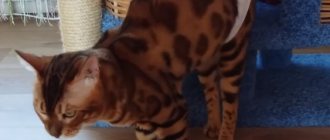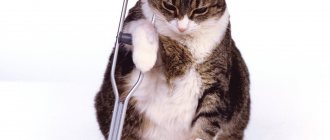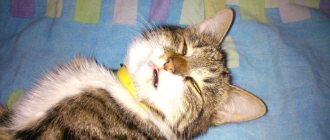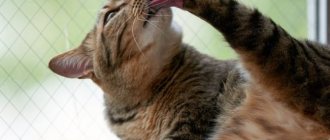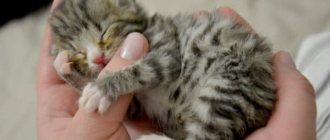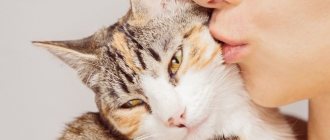Method of communication
By behavior you can understand what the animal wants to say.
If the ears are pressed tightly to the head and turned back, the hair on the body is raised - it means that the cat is tense or scared, as it feels threatened. You need to behave kindly with your pet and calm him down. The cat lies on the ground, then presses its ears, then pricks them up, this means that it is very keen and is hunting. At this moment, it is better not to touch the animal or disturb it.
The cat also flattens its ears when its head is stroked or when it rubs itself. A strong, loud noise will also cause a cat to flatten its ears. In all other cases, they stick out and pick up the slightest sounds.
Ear flattening as a way to express emotions
Before you worry about the health of a cat that presses its ears to its head, you need to track the situation in which it does this. Perhaps this behavior is just a way of communicating and showing certain emotions. In a number of situations, pets demonstrate their mental and physical state in a similar way:
- Stroking . A cat always presses its ears to its head when being petted - it does this to show maximum pleasure and demonstrate its desire to receive more affection.
- Manifestation of the hunting instinct . Seeing a fly or mosquito, the cat begins to hunt for it. At first, her ears are raised high as a sign of maximum concentration and attention to the object. When approaching a target, the ears will be pressed to the head.
- Protection . When a pet caresses its owner's leg or scratches its head on an object, it will press its ears to its head so as not to touch them.
- Manifestation of fear . In this situation, not only will the ears change their direction, but the cat’s entire posture will be as compact as possible.
- During sleep . By pressing its ears to its head, the cat retains maximum heat inside the body. Pets do this mainly during cold weather.
- Fright . A sharp, irritating sound suddenly heard by a cat will initially frighten it, causing its ears to immediately drop to its head. Only after a second, having calmed down, she will raise her ears, looking for the source of irritation.
- Display of sexual behavior. Unsterilized animals often flatten their ears due to sexual heat, indicating their readiness to reproduce.
You should be wary of a situation when a cat changes the direction of its ears for no apparent reason, and also shakes its head.
Such a symptom may indicate the presence of certain diseases and pathological conditions in the animal.
Cleaning the ears
At home, so as not to harm the pet? Now let's look at this topic in detail. First, I would like to note that for this procedure you will need sticks with limiters, boiled water and gauze swabs. If the animal's ears are very dirty, you can use a pharmaceutical saline solution NaCl 0.9% (sterile) or lotion, which is sold in pet stores.
You should not use peroxide, soap solutions, alcohol-containing compounds and other folk remedies for cleaning. Such liquids can harm the animal. These products may lead to the formation of small ulcers, drying out of the skin, and increased production of sulfur. The shape of a cat's ear allows the owner to remove excess secretions only from the visible surfaces of the shell.
During this event, do not use force or try to “twist” the cat. You can achieve obedience with affection and persuasion. You can wipe the ear with a gauze swab if a little wax has accumulated in it. If there is a large amount of it, saline solution should be dripped into the ear canal. Afterwards, you should gently massage the ear so that the liquid penetrates deep.
This hygiene procedure should be carried out as needed. There is no need to achieve sterile cleanliness. For most cats, one brushing per month will be sufficient.
How to clean a cat's ears at home so as not to harm your pet? Now let's look at this topic in detail. First, I would like to note that for this procedure you will need sticks with limiters, boiled water and gauze swabs. If the animal's ears are very dirty, you can use a pharmaceutical saline solution NaCl 0.9% (sterile) or lotion, which is sold in pet stores.
Pathologies
You should be wary if the cat not only presses its ears back, but also shakes its head. There may be several reasons:
- Pain.
- Feeling of pressure.
- Sound sensations or other phenomena similar to hallucinations.
- Neurological disorders.
Pain can be of different nature. Some cats sense changes in atmospheric pressure, that is, they are weather dependent. The pathology can develop against the background of brain dysfunction or a neoplasm that increases intracranial pressure. Of course, the reasons can be much simpler, for example, slight discomfort after cleaning the ears.
The cause may also be water that gets into the ears while swimming. There is a very old scare that if water gets into an animal's ear, it will go rabid. – this is a virus and it has nothing to do with water, but the inflammatory process can begin from running water. Any inflammation is painful, and if it is in the ear, it can quickly reach the brain, which will explain the animal’s inappropriate behavior.
If a cat presses one ear, it's most likely due to... Elderly street cats often have asymmetry in the set of their ears - this is a consequence of having experienced a severe form of otitis media; it must be said that such animals are lucky to survive. The infection enters the second ear while washing and the inflammation becomes bilateral.
A cause for concern should be if your cat is constantly pressing one ear. At the same time, she shakes her head and often scratches her ear. Possible reasons for this:
- foreign body;
- swelling;
- mite;
- otitis;
- dirt.
Any of these reasons will cause discomfort to the animal. Both the left and right ears can suffer. If you notice that the ear is often pressed to the head, you need to examine the cat's ears. This will allow us to identify what caused these symptoms.
Ear dirt can be easily removed by yourself. It is only recommended to do this very carefully, since sloppy and rough movements lead to injuries to the ear canal. If a foreign body is detected, you can remove it yourself. If the attempt is unsuccessful, it is better to contact a veterinarian for qualified assistance.
Severe itching of the ear causes mite infestation. The mite can be ear or subcutaneous. The first species lives directly in the ear canal. Its presence, in addition to itching, is accompanied by discharge from the ear and the appearance of plaque. The subcutaneous mite most often settles above the eyes and near the ears in the superficial layers of the skin.
Constant observation and care of your beloved pet will help him always remain healthy and cheerful, and the owner calm!
If you're trying to understand what's going on in your cat's head, interpreting her body language will be just as important as understanding the sounds she makes. Cats constantly talk to us through their bodies - often much more than through their voices. You've probably noticed some of the behaviors that your cat shows you - twitching its tail, stretching out on its back, exposing its belly, looking at you with narrowed eyes and blinking slowly... Is it possible to understand what all this means? Definitely! This article talks about what your cat is trying to tell you through body language and explains what certain behaviors mean.
1. Tail
Tail wagging (that is, the entire tail moving slowly and gently from side to side) usually means that the cat is alert, curious, or interested in something.
Tail wagging: If a cat is wagging its tail (the entire tail moving quickly and violently from side to side), it means that it is agitated and very irritated. Sometimes this will cause the cat's entire body to take on an aggressive stance (more on this below.) The hair on her tail may stand on end, giving it a fluffy appearance. If you see a cat in this condition, it is better to leave it alone, otherwise you may become a victim of an attack!
Twitching. If a cat twitches the tip of its tail, this usually indicates that it is interested in what it is seeing. However, it can also be the first sign of aggression - for example, if another cat has just invaded its territory.
Trembling. Cats have tails that quiver at the base when they mark their territory. However, this behavior can be observed when the cat rubs against your legs, when you rub its back or scratch it (especially near the tail), while it stands. In this case, the trembling of the tail is a sign of her great love for you.
Straight, raised tail. If a cat is walking and its tail is in a vertical position (pointing to the sky), it means that it is happy, content and confident.
Tail half tucked between legs. This usually means the cat is afraid, unhappy, or feels threatened. The rest of her body will confirm this (eg head down, ears flattened, body crouched towards the ground).
2. Ears
The cat perked up its ears. This means that your pet is interested in what she hears around her. You may notice that your cat moves its ears to hear what is happening behind it without moving its head.
Ears are pressed to the head. If the ears are pressed to the head and turned back, then the cat feels threatened and seeks to protect them.
3. Head and mustache
Head raised. The meaning of this gesture varies depending on the circumstances. If the cat is happy, a raised head indicates curiosity and confidence, and is usually combined with perked ears. On the other hand, if he is in a confrontation with another cat, a raised head indicates dominance and in this case the ears will be flat against the head.
We suggest you read: Names for Thai cats How to name them
Head down. When confronting another cat, a lowered head indicates submission. In other circumstances, a lowered head may indicate sleepiness, contentment, or boredom.
Cat's whiskers. Whiskers can serve as an indicator of a cat's mood. If the whiskers are forward, the cat is relaxed, content, or curious. If they are pulled back, the cat is preparing to defend itself or attack.
4. Eyes
Wide-open eyes, intent gaze. As a rule, cats look this way during a fight or before attacking another animal or person. They look like that, trying to scare them.
Squinted eyes, slow blinking. This means the opposite of what was discussed above - the cat is saying that it is happy to be around another cat, animal or person and that it trusts them.
5. Body
Shifting paws. It is a sign of love, comfort and satisfaction.
The cat rubs against your legs. When your pet does this, she leaves her scent on you, marking you as part of “her territory.” This is a sign of love.
The cat rolls over onto its back and exposes its belly. This is how the cat shows its submission. She compliments you, saying that she loves and trusts you.
Straight paws. If the cat's paws are straight and upright, head up and ears perked, the cat is happy, curious and confident. Conversely, flexed front and rear legs indicate that the cat prefers to avoid a fight, but will defend itself if necessary.
Arched back. In kittens this is usually a playful position - they want to play fight. In adult cats, however, this usually means that the cat is preparing for a real fight. This stance is accompanied by flattened ears, wide open eyes and the hair standing on end on the back and tail.
When you're trying to interpret a cat's body language, it's important to look at the whole body, not just one specific part. It is important to take into account the environment and the cat’s voice messages. I hope you have fun, have fun, and have a lot of positive experiences while trying to understand her!
Why does the cat shake his head and scratch his ears? We will talk about this in our article. We will look at the main reasons for this behavior of the animal. But before that, let's talk about keeping a cat at home. This topic is very important for owners. After all, their condition depends on proper ear hygiene. Of course, the cleaning procedure is not particularly pleasant for cats. But such an event cannot be avoided. It is worth getting used to the procedure from early childhood.
" article "The language of cats and cats: a cat phrasebook." Where we will look at how cats and cats can communicate with each other - and with people.
The language of cats and cats: the cat phrasebook is actually quite logical and simple. So many people understand it intuitively. However, for those who do not understand - or for those who want to understand better - we offer a small cat-human phrasebook. Let's start with the individual parts of the cat and end with general poses.
Why does a cat press one ear?
Calm and reasonable Margot, the cat dreams of quickly finding a home and a loving family.
You've probably noticed more than once how a cat flattens its ears when communicating with people or relatives. This is one of the ways to express emotions in cat language. However, sometimes such an action can serve as a symptom of a disease. Of course, any ambiguous situation needs to be sorted out so as not to miss the disease. We at the Murkosha shelter have been observing cats for several years now, so we will try to give the most detailed answer about the possible causes of this phenomenon.
???? Cat's body language or emotions
Talk to any dog owner or watch them play with their pets. The dog flattens its ears, crouches to the ground and wags its tail - it is happy, playing and generally having a good time. Flatten your ears and wag your tail = smile.
In cat language, everything is exactly the opposite: flattened ears and wagging tail = dissatisfaction. If the cat crouched to the ground, or arched, fluffing its fur and bending its tail, this is already an aggressive stance. Sharp movements of the tail, flattened ears and growling already indicate that he is ready to attack.
What is a sign of joy for a dog is a sign of dissatisfaction for a cat. Does your pet flatten its ears and wag its tail? Leave him alone, but watch. If after a while he calms down and starts licking himself, then everything is fine - the animal was just scared of something.
These are the wonderful greetings from home from the cat Justine (now Toffee, aka Sausage, Sausage and Irison), who left the shelter home on April 23, 2021. Considering her terrible past, at first it happened at home that the cat would suddenly rush to her feet with her claws and every time they reached out to pet her, she would flatten her ears and lower her head, but now there is no trace of this))
???? But there are other options:
1. You stroke your pet on the head and back - he presses his ears to get maximum pleasure.
2. The cat periodically shakes its head and presses its ears.
3. The cat scratches its head on some object or rubs against you - ears are pressed down so as not to interfere.
In general, the direction in which the ears turn indicates the object that interests the animal. In hunting mode, the ears will first be raised to accurately determine the location of the object, and at a close distance the cat will press its ears to protect them, because large prey will not give up without a fight and will attack the neck and muzzle area. In addition, this way the cat is less noticeable to the victim.
In case of severe fright, the behavior is partially repeated - the most compact posture with ears flattened, eyes wide open. The pet looks meek, but at the slightest opportunity it will run away with its ears raised and tail spread out.
The main causes of the disease
Why does my cat often scratch his ears and shake his head? Now let's look at the main reasons. Note that if an animal scratches its head or ear once, this is quite normal.
Normally, a cat may itch several (two to three) times a day. But if this is repeated constantly, and the pet is nervous, tears its skin, and experiences discomfort all the time, this is a real cause for concern. Why does the cat shake his head and scratch his ears? The main reasons that cause such inconveniences include:
- scabies mite;
- untreated hematoma;
- water or a foreign object that gets into the ear;
- accumulation of sulfur;
- infections that cause inflammation;
- injuries from scratches or bites.
It should only be selected in conjunction with the treating veterinarian. If you start treating your four-legged friend for a tick, and he ends up with otitis media, the disease can cause serious complications, including hearing loss.
Regardless of the chosen tactics, if a cat shakes its ears, treatment should be carried out under the supervision of a specialist and methodically. You must visit the veterinarian at least once a week to monitor the condition of your four-legged friend.
If you are unable to do this, then it is better to leave your pet for inpatient treatment.
If a cat scratches its ears, what should you do? Of course, treat. The nature of the therapy directly depends on what disease the cat (kitten) has. For example, for otitis, special drops are used. They contain antibiotics. If an animal has parasites, then antiparasitic drugs are used. When placing drops, you need to control them so that they are evenly distributed throughout the sink. Sometimes injections are prescribed. There are times when surgery is required.
Treatment of ear diseases
It should only be selected in conjunction with the treating veterinarian. If you start treating your four-legged friend for a tick, and he ends up with otitis media, the disease can cause serious complications, including hearing loss.
Regardless of the chosen tactics, if a cat shakes its ears, treatment should be carried out under the supervision of a specialist and methodically. You must visit the veterinarian at least once a week to monitor the condition of your four-legged friend.
If you are unable to do this, then it is better to leave your pet for inpatient treatment.
Cat ear diseases
The basis of prevention is limiting contact with stray animals. They are the ones who pose the greatest risk of infecting your pet with ticks, fleas or otitis media. Also important:
- Maintain ear canal hygiene. To do this, you can clean them with a cotton swab and a disinfectant, for example, Otodepin drops.
- Wash the animal carefully so that water does not get inside the ear canal.
- Strengthen your four-legged friend's immunity with mineral supplements and a balanced diet.
It is equally important to regularly examine the animal and observe its behavior. If alarming symptoms are detected, you should urgently consult a veterinarian for advice.
As can be seen from the article, a cat does not always scratch its ears because it is sick. If the condition is accompanied by other unpleasant symptoms, and the behavior of your four-legged friend has changed, then this becomes a good reason to contact a veterinarian. With proper treatment, the animal will forget about problems with the ear canal, and compliance with preventive measures will help to avoid them in the future.
Video on the topic
As mentioned above, if a cat starts shaking its head, it most likely has an earache. In this case, head shaking is provoked by the desire to stop the discomfort. Note that sudden movements partially help dull the pain.
In veterinary medicine, there are more than a dozen diseases that can cause ear pain, itching, blurred vision, dizziness... and all these symptoms will cause the cat to shake its head. Even toothache can lead to similar behavior.
Let's look at the symptoms of the most common diseases. A relatively rare phenomenon in cats is weather dependence. Simply put, a cat gets a headache when its blood pressure changes. You will not be able to officially confirm this diagnosis, but it can be easily identified by observing the animal’s behavior.
Prevention of ear canal diseases
The basis of prevention is limiting contact with stray animals. They are the ones who pose the greatest risk of infecting your pet with ticks, fleas or otitis media. Also important:
- Maintain ear canal hygiene. To do this, you can clean them with a cotton swab and a disinfectant, for example, Otodepin drops.
- Wash the animal carefully so that water does not get inside the ear canal.
- Strengthen your four-legged friend's immunity with mineral supplements and a balanced diet.
It is equally important to regularly examine the animal and observe its behavior. If alarming symptoms are detected, you should urgently consult a veterinarian for advice.
As can be seen from the article, a cat does not always scratch its ears because it is sick. If the condition is accompanied by other unpleasant symptoms, and the behavior of your four-legged friend has changed, then this becomes a good reason to contact a veterinarian. With proper treatment, the animal will forget about problems with the ear canal, and compliance with preventive measures will help to avoid them in the future.
Video on the topic
What to do if your cat shakes its head, flattens its ears, or constantly scratches its head. It is clear to any owner that the pet is experiencing discomfort and pain, but how to identify the causes of the disease? Let's look at the main types of diseases that can cause knots, headaches or affect the ears.
If a cat shakes its head frequently or too intensely, there is a reason for this; it may be due to illness or exposure to the external environment. This behavior cannot be left to chance, since many diseases can have irreversible consequences.
The most common reasons why a cat shakes its head is pain or itching. When a pet suffers from itching, the problem is most often localized in the ear area. When a cat scratches its ears with its hind paws, it releases its claws and severely injures the skin. Scratches become swollen and infected, leading to pain.
The conclusion suggests itself - itching is only a symptom, and the true cause of head shaking is always pain.
There is also an option that is not associated with illnesses - this is a foreign body stuck in the ear canal or blocking it
. If you suspect that there is something in your cat's ear, it is strongly recommended that you do not try to treat it at home. By contacting a professional, you can be sure that immobilizing measures will be applied to the animal if the condition threatens to worsen.
If you try to get the object yourself, the pet may jerk and the foreign body will push even deeper. Keep in mind that cats have an L-shaped ear canal, which is also thin and sensitive.
Are you sure there's nothing stuck in your pet's ear? In this case, the cause may be the accumulation of sulfur or disease
. As mentioned above, cats have an L-shaped ear canal, which can make wax plugs invisible. If you haven't cleaned your cats' ears as a preventive measure, it is recommended that you contact your veterinarian. The doctor will clean the pet's ear canals with a special solution that softens the wax and allows it to come out of the ear naturally. Of course, you can do all these procedures yourself, but if the cause of discomfort is not wax plugs, getting liquid into the ear canals is highly undesirable.
Many owners, noticing that their pet has ear pain, begin treatment with broad-spectrum drops on their own. Quite often this method works, although it is not entirely correct. For adequate therapy that will not harm the pet’s health, it is necessary to identify the exact cause of the discomfort. The use of medications based on intuitive sensations is also a method of treatment, but it is relevant if the doctor cannot find the cause and acts by exclusion.
When a cat shakes its head, the cause is most likely in the ears, but there are other options. If the problem is not identified at the first visit to the veterinarian, the diagnostic process will be delayed. The pet will be prescribed symptomatic treatment, and the owner will need to pay maximum attention to the cat’s behavior and changes in it.
Insufficient hygiene
Cats that live indoors are not as susceptible as those that roam the streets. But you need to take care of your hearing hygiene in any case. Therefore, if your cat is shaking his head and scratching his ears, then take him to the vet. If there is an unpleasant odor and an accumulation of brown discharge, then most likely the animal has otodecosis, which we will discuss later.
This is a fairly serious disease, so you need to choose the right therapy. In addition to regularly cleaning your cat’s ears to remove plaque, systematic prevention should be carried out. Since such a serious disease can be transmitted to other animals. It is also necessary to periodically examine your pet's ears. Since poor hygiene and advanced disease can lead to more serious consequences.
Cats that live indoors are not as susceptible to ear diseases as those that roam the streets. But you need to take care of your hearing hygiene in any case. Therefore, if your cat is shaking his head and scratching his ears, then take him to the vet. If there is an unpleasant odor and an accumulation of brown discharge, then most likely the animal has otodecosis, which we will discuss later.
This is a fairly serious disease, so you need to choose the right therapy. In addition to regularly cleaning your cat’s ears to remove plaque, systematic prevention should be carried out. Since such a serious disease can be transmitted to other animals. It is also necessary to periodically examine your pet's ears. Since poor hygiene and advanced disease can lead to more serious consequences.
We suggest you read: What to do when a cat has pain near its tail
My cat's ears itch - is this normal?
It is normal for a living creature to scratch its ears. This way the pet cleans them of dirt and foreign particles. He can do this up to several times a day and it will be within normal limits. When does ear scratching cease to be a daily hygiene procedure? It is worth noting that:
- The animal is worried when scratching, the cat shakes its head irritably and actively.
- The pet became nervous and irritable.
- When brushing, the cat purrs or hisses.
- Scratching became more frequent up to 10 times a day.
- Bleeding wounds appeared in or behind the ears.
If several of the listed signs coincide, you should think about visiting a veterinarian.
Otitis and its varieties
When a cat scratches its ears and shakes its head violently, the cause may also be otitis media. Some cat breeds are prone to this type of disease. Regular prevention - examining the ears and cleaning them reduces the risks to a minimum, but does not eliminate them.
Otitis is an inflammatory process affecting the external, middle or internal auditory canal. There may be several reasons for the development of such a pathology:
- excess wax in the ears;
- colds caused by prolonged exposure to the cold;
- foreign bodies entering the ear;
- infections;
- allergy;
- diseases of internal organs (liver, pancreas);
- fungus;
- complication of notoedorza or otodecosis.
To prescribe the correct treatment, it is necessary to diagnose the cause of the disease in a specialized laboratory. The veterinarian must take a swab from the cat's ear for analysis.
In this case, the so-called bacterial or secondary otitis develops. It can be recognized by the abundant discharge of pus.
The cat scratches his ear and shakes his head
A cat, by nature, may scratch its ears and shake its head several times a day; this is normal. But if such actions are observed frequently, and the animal tries to scratch its ears, becomes nervous and irritable, such behavior may indicate a disease. There are predisposing, primary and secondary factors for this behavior.
Predisposing factors:
- Blockage of the ear canal: neoplasms, polyps, granulomas.
- Features of the breed: the anatomical structure of the auricle or a narrow ear canal, which is often congenital.
- Excessive production of earwax - this can be a congenital disease when the cerumen glands become enlarged and produce a large amount of secretion.
- Iatrogenic complications - during the cleaning period the ear canal is injured, or inappropriate medications were used to treat the auricle.
Primary factors:
Secondary factors:
- Yeasts and fungi can reside in a healthy ear and cause disease.
- When bacterial flora - streptococci - is present in the ear canal.
- Frequent or deep cleaning is improper care.
- Inflammation of the middle auditory canal.
A good owner can learn a lot from the nature of the discharge from the animal's ear canal. When wax accumulates in a cat's ears, it has a brown color, an unpleasant and pungent odor, and contains blood or pus, you should contact a veterinarian for diagnosis and treatment. If this is not done, the animal will have a perforation of the eardrum, or complete deafness will occur.
When walking down the street, dust gets clogged into the cat's ear canal, the secretion of wax increases, and ear itching appears. Foreign objects or plant seeds get into the ears; if they are not removed in time, acute inflammation or allergic reactions occur.
Breeders should inspect the animal’s ears regularly, clean them, and remove plaque with specially created preventive medications.
Gray pellets in the ear canal and itching may indicate damage to the pet's liver or pancreas.
Severe itching may be a warning sign of ear mites (ear scabies).
Ear mite
What are the main signs of this disease? In addition to itching in the ears, in the shells themselves, you can replace brown plaque, as well as sticky liquid. The consequences of such a disease are serious, including membrane rupture, meningitis, and others. If there is a problem with one ear, then both should still be treated.
Why does the cat shake his head and scratch his ears? It is possible that the animal has otodecosis. What kind of disease is this? Otherwise, the disease is also called scabies, or ear mites. This disease mainly affects weakened individuals, as well as those living in large groups. Typically, the mite parasitizes in the external passage or on the inside of the ear.
Prevention of ear diseases in cats consists of the following measures.
This is done approximately once a week, sometimes 2 times a week. Before cleaning, you can spray a special preventative spray into your ears, which helps remove wax and has a disinfecting and healing effect. It is best if it is based on natural ingredients. Just don’t buy a spray with antibiotics for prevention, it’s pointless and harmful to health.
Video on the topic
A cat constantly scratches its ear and shakes its head if it has parasites. Infection with ear mites occurs from other cats; contact with street animals is especially dangerous.
This mite is not dangerous to humans; it lives and reproduces only in animals, causing ear scabies or otodecosis in them. Adult dogs and cats rarely suffer from scabies, but ear mites are found much more often in puppies and kittens.
The parasite is localized in the ear area or around it. In the animal's ears, you can notice a sticky brown liquid that dries and crusts over the skin of the ear. To diagnose the disease, a scraping is made from the skin in the ear area. The owner himself can notice the tick using a magnifying glass.
If your cat's ears are shaking, this could be a sign that she has another type of mite. Such mites can spread not only in the ear area, but also in other parts of the cat’s body. They cause another feline disease, notoedrosis.
To make an accurate diagnosis, you need to show the cat to a specialist. He will take a sample from the surface of the skin for analysis. Only the outermost layer from the inflamed area is scraped off; ticks can be seen there.
Both types of ticks provoke severe itching in the animal, forcing them to scratch the skin until it bleeds. Scabies that affects the ears can lead a cat to deafness or meningitis; in especially severe cases, the death of the pet can occur.
Why does a cat curl his ear?
Calm and reasonable Margot, the cat dreams of quickly finding a home and a loving family.
You've probably noticed more than once how a cat flattens its ears when communicating with people or relatives. This is one of the ways to express emotions in cat language. However, sometimes such an action can serve as a symptom of a disease. Of course, any ambiguous situation needs to be sorted out so as not to miss the disease. We at the Murkosha shelter have been observing cats for several years now, so we will try to give the most detailed answer about the possible causes of this phenomenon.
???? Cat's body language or emotions
Talk to any dog owner or watch them play with their pets. The dog flattens its ears, crouches to the ground and wags its tail - it is happy, playing and generally having a good time. Flatten your ears and wag your tail = smile.
In cat language, everything is exactly the opposite: flattened ears and wagging tail = dissatisfaction. If the cat crouched to the ground, or arched, fluffing its fur and bending its tail, this is already an aggressive stance. Sharp movements of the tail, flattened ears and growling already indicate that he is ready to attack.
What is a sign of joy for a dog is a sign of dissatisfaction for a cat. Does your pet flatten its ears and wag its tail? Leave him alone, but watch. If after a while he calms down and starts licking himself, then everything is fine - the animal was just scared of something.
These are the wonderful greetings from home from the cat Justine (now Toffee, aka Sausage, Sausage and Irison), who left the shelter home on April 23, 2021. Considering her terrible past, at first it happened at home that the cat would suddenly rush to her feet with her claws and every time they reached out to pet her, she would flatten her ears and lower her head, but now there is no trace of this))
???? But there are other options:
1. You stroke your pet on the head and back - he presses his ears to get maximum pleasure.
2. The cat periodically shakes its head and presses its ears.
3. The cat scratches its head on some object or rubs against you - ears are pressed down so as not to interfere.
In general, the direction in which the ears turn indicates the object that interests the animal. In hunting mode, the ears will first be raised to accurately determine the location of the object, and at a close distance the cat will press its ears to protect them, because large prey will not give up without a fight and will attack the neck and muzzle area. In addition, this way the cat is less noticeable to the victim.
In case of severe fright, the behavior is partially repeated - the most compact posture with ears flattened, eyes wide open. The pet looks meek, but at the slightest opportunity it will run away with its ears raised and tail spread out.
Ear infection
Why does a cat shake his head from side to side and scratch his ears? It is possible that he has inflammation of the inner, outer or middle ear. This disease may appear due to untreated or severe scabies. Other causes of inflammation:
- sulfur plug;
- hypothermia;
- foreign object in the ear.
Sometimes this disease is provoked by infections. If there is pancreatic or liver dysfunction, the cat may also scratch its ears. Brown pellets are also observed in the shells.
Symptoms of the disease:
- Itching in the ears.
- Uncontrolled head movements.
- Decreased appetite.
- Fluid in the ears.
If your animal has a large sulfur plug, you should contact a veterinarian. You can also get rid of it at home. To do this you will need either peroxide or saline solution. The product should be dripped for a week, three times a day. Afterwards, the cat will be able to get rid of the plug on its own. If you have problems, you should contact the clinic.
Ear examination
Examination of a cat's ears should be a regular procedure, and the animal should be accustomed to it from a very early age. The pet will get used to it and it will not cause negative reactions in him. The owner should pay attention to factors such as:
- accumulation of sulfur and dirt;
- unpleasant odor;
- blood;
- inflammation and redness;
- wounds and scratches;
- Frequent shaking of ears and head.
The last sign may serve as a signal that the cat has ear mites.
Check the animal's hearing, dirt, odor, discharge, redness and pain. If you notice any symptoms, be sure to contact your veterinarian.
Allergy
Why does a cat scratch his ear, but it is clean? It is possible that the animal is allergic to some product. In order to determine exactly what food the reaction is occurring to, various tests are performed. They also give antihistamines and local (drops and other) medications.
Now it’s clear, he’s scratching his ears and head. As you can see, there are many reasons for this animal behavior. Therefore, be sure to clean your pet’s ears on time; we have described how to do this. Proper hygiene of an animal’s ears is an excellent prevention of disease.
WHY A CAT PRESSES EARS: WE OBSERVE AND STUDY THE PET'S BEHAVIOR When communicating with the owner or expressing emotions, the cat presses its ears. This is just a small but very significant part of body language. If you think that your pet is pinning its ears for no good reason, you should carefully observe its behavior. A cat's ears are very sensitive, and their position and movements can indicate a variety of phenomena.
EMOTIONS – BODY LANGUAGE Dog lovers are not surprised when their dogs flatten their ears and wag their tails, because this expresses joy. In a similar situation, when a cat pins its ears back to its head and wags its tail, it is better to leave it alone, as this behavior shows clear displeasure or irritation.
When showing tenderness, cats usually do not flatten their ears, but there are other options: – The pet presses its ears in response to stroking. – The cat flattens its ears when it rubs its head. In other situations, the ears are always turned forward, as if catching the actions of the owner. When sleeping, cats often curl up into a ball, pressing their ears.
Hunting is a process in which four-legged animals actively use hearing to track down prey, but once the target is detected, the cat's tactics change. She presses herself to the ground, moves as slowly and silently as possible, even the movements of her eyelids become smoother. The cat then flattens its ears to make its silhouette smoother and less noticeable.
Movements are made only on half-bent legs and when the victim turns away. When hunting large prey (for example, a rat), the cat presses its ears for protection. Not all rodents give up without a fight and can attack in the face or neck area. Fright or severe discomfort is also accompanied by a posture with the ears pressed back.
Visually, the animal looks insecure and meek. As soon as the danger has passed, the pet raises its ears and retreats away from the irritant or threat. PHYSIOLOGICAL REASONS Cats are very attentive animals and they very rarely flatten their ears without reason. Most often, the stimulus is external stimuli, such as noise.
A small noise will not make the cat cover its ears; rather, on the contrary, the pet will go towards the source of the sound and try to find out what the reason is. The sound produced by an ultrasonic whistle or repeller is not audible to people, but animals do not tolerate it well. This whistle can be compared to a strong, prolonged squeak, which also echoes.
We suggest you read: Blepharitis in cats, symptoms and causes
Ultrasound is produced by pyrotechnic installations and some household appliances. The cat’s natural reaction to such an irritant will be to move away from the source. A natural and immediate reaction to bright light may be to close your eyes and flatten your ears. The reason is severe irritation of the mucous membranes and brain.
The fact is that dilated pupils will let too much light into the retina. The effect can be compared to a silent flashbang, when the flash is so bright that it blocks your ears. A cat may flatten its ears if it is cold. Thus, two positive effects are achieved at once: The sensitive skin of the ears stops tingling.
The muscles become toned and the blood flow in the vessels improves. The cat warms its ears on its neck. Unsterilized cats and female cats flatten their ears when in heat. This phenomenon is more clearly expressed in a cat, which arches its back, rolls on the floor, squints its eyes, flattens its ears and screams. PATHOLOGIES You should be wary if the cat not only presses its ears back, but also shakes its head.
There may be several reasons: – Pain. - Itching. – Feeling of pressure. – Sound sensations or other phenomena similar to hallucinations. Neurological disorders. Pain can be of different nature. Some cats sense changes in atmospheric pressure, that is, they are weather dependent. The pathology can develop against the background of brain dysfunction or a neoplasm that increases intracranial pressure.
Of course, the reasons can be much simpler, for example, slight discomfort after cleaning the ears. The cause may also be water that gets into the ears while swimming. If a cat presses one ear, it is most likely due to otitis media. Elderly street cats often have asymmetry in the set of their ears - this is a consequence of having experienced a severe form of otitis media; it must be said that such animals are lucky to survive.
– Ear – lives and reproduces directly in the ear canals, can be identified by itching and a brown, soft coating. – Subcutaneous – lives in the upper layers of the skin above the eyes, in the area around the ears (spreads throughout the body and is contagious). Literally in the first days after infection, the cat scratches its ears and face until it bleeds. To do this, you need to contact your veterinarian in a timely manner.
Sometimes the owner notices that his cat is shaking his head and scratching his ears. Experienced cat owners are well aware that this pet behavior can be caused by a serious illness.
Why does a cat press its ears to its head?
The body of felines is incredibly mobile. Pets easily show their state, both emotional and physical, through movements. What can a cat's flattened ears mean, and should the owner worry about his pet?
A healthy thicket animal combines ear pinching with other movements:
- When the ears are pulled back and the tail is actively moving from side to side, then the cat is definitely dissatisfied with something. The cause is loud noise, sudden movements, unpleasant caress.
- A sign of hunting or attack is a situation in which the cat flattens its ears and lies on the floor, without taking its eyes off the prey. This condition may be accompanied by growling, twitching, or tail wagging. During the fight, the animal tries to protect itself from injury in the same way.
- If, when stroking, the cat only lowers its ears, but otherwise behaves calmly, then the pet is happy and enjoys it.
- Also, when scratching its head, the animal may move its ears away, just so as not to interfere.
- Grouping of the entire body, including the ears, indicates fear or lack of warmth.
When normal behavior options are excluded, and the cat presses its ears to its head, the cause is itching, pain or disturbances in the functioning of the body. The following factors are cause for concern:
- Accumulation of earwax. In the absence of care or due to the individual characteristics of the body, a large amount of sulfur accumulates inside the sink, which blocks the ear canal and causes discomfort. By moving its ears, the animal tries to get rid of the plug. You should help your pet carefully, and it is better to go to a veterinary clinic.
- Careless cleaning. Discomfort inside the auricle can be caused by a scratch or a damaged membrane as a result of cleaning. Therefore, for regular hygiene it is worth using special sprays, sticks with limiters, soft tampons, and never use force.
- Injury. Cats that spend a lot of time outdoors are more susceptible to ear damage. There may be foreign objects inside the ear canal, which it is recommended not to remove yourself, but to visit a veterinarian. Wounds also appear as a result of fights or falls; they should be treated with healing agents. And if a hematoma appears, you need to go to the clinic for an accurate diagnosis.
- Allergic reaction. Discomfort sometimes causes an allergy to a new food or its component. This condition is often accompanied by itching or skin dermatitis. At the same time, the animal shakes its head, and small weeping ulcers appear on the inner surface of the ear. First aid is to stop feeding, use antihistamines and treat ulcers.
- Otitis. If there is inflammation in the ear canal, the cat presses its ears back and also becomes less mobile. The condition may be accompanied by fever or decreased appetite. The reasons are: hypothermia, drafts, colds, liver or pancreas diseases, or complications due to other factors. The presence of pus in the canal indicates the possibility of a bacterial infection. To establish a diagnosis, a laboratory analysis of a smear from the animal’s ear is performed.
- Presence of a tick. Close-fitting ears and constant scratching most often indicate otodecosis caused by ear mites. Parasites cause severe itching, discharge of pus or a sticky substance, and the formation of bloody crusts at the site of scratching. To treat cats, special drops are used in combination with antibiotics. Infection with the sarcopid mite, which also affects the nasopharynx and eyes, and affects the heart, blood vessels and nervous system, is considered more rare and dangerous.
- Flea bites. In the absence of damage or discharge, pinching and scratching of the ears may be the result of fleas. The cat should be examined, and if parasites are found, washed and treated.
- Fungal infection. Violation of the microflora with a decrease in immunity can cause active proliferation of the fungus. The disease does not cause itching, but causes the cat to shake its head and fold its ears. Treatment includes daily treatment with antifungal drops, as well as oral medications.
- Water. When moisture gets into the ear canal, the cat instinctively tries to remove the fluid by pressing one or both ears. If your pet can’t cope on his own, you can carefully remove the water with a cotton swab.
- Reaction to changes in blood or atmospheric pressure. Sudden jumps cause a headache in the pet, and pressing the shells to the head indicates the individuality of the cat, which thus reacts to the problem.
- Neuralgia. Disruption of the brain or nervous system provokes auditory hallucinations. In this case, the cat presses its ears to its head due to perceived noises or sounds.
- Neoplasms. Ear pinching may be associated with more serious medical conditions. The formation of benign or malignant tumors causes discomfort in cats. The sooner the disease is diagnosed in the clinic, the higher the likelihood of keeping the cat healthy.
To prevent problems with the hearing organs, you should be careful when carrying out hygiene procedures, avoid hypothermia, strengthen your immune system, and not self-medicate.
Why does a cat scratch its ears?
It is normal for pets to scratch their ears. So they independently clean them of foreign particles and dirt. An animal can perform this necessary hygienic procedure several times a day; there is nothing unnatural about this. But there are some signs that should alert the owner:
- The cat scratches its ears continuously and at the same time strongly shakes its head in one direction or the other, as if trying to free itself from some object.
- The cat becomes restless, irritable, and sometimes aggressive.
- When scratching its ears, the animal can make various sounds, hiss, purr, and meow.
- Scratches, wounds, and sores appear behind the ears and in the shells, causing painful discomfort to the cat.
Why do my cat's ears itch? The causes of this phenomenon are usually divided into two groups - everyday and pathological.
Household infections can be diagnosed by owners, go away on their own after some time and do not require drug treatment. These include:
- Getting water into your ears after swimming.
- Foreign body.
- Minor hematoma resulting from trauma.
- A large amount of sulfur accumulated in shells due to insufficient care, which the cat is not able to remove without outside help.
It may well be that the cat simply rested his ear and is scratching it because of this, so before you run to the veterinary clinic, you should observe the pet’s behavior.
Pathological causes pose a serious danger to the health of the cat, these include:
- otitis;
- fleas;
- allergy;
- neoplasms in the ears, including malignant ones;
- fungal infections;
- dermatitis;
- ear mites (otodectosis);
- abscess.
These diseases require immediate treatment; the veterinarian will tell you what to do in such cases.
The problem of diagnosing a cat’s condition, no matter how trivial it may be, is that it is impossible to directly ask the “patient” about his problem. For this reason, owners have to independently observe and analyze the pet’s behavior. And often they go too far, not knowing what is normal for a cat and what is not. The same thing happens with scratching the ears. Why do my cat's ears itch and when does it become a problem?
It is normal for a living creature to scratch its ears. This way the pet cleans them of dirt and foreign particles. He can do this up to several times a day and it will be within normal limits. When does ear scratching cease to be a daily hygiene procedure? It is worth noting that:
- The animal is worried when scratching, the cat shakes its head irritably and actively.
- The pet became nervous and irritable.
- When brushing, the cat purrs or hisses.
- Scratching became more frequent up to 10 times a day.
- Bleeding wounds appeared in or behind the ears.
If several of the listed signs coincide, you should think about visiting a veterinarian.
When a cat presses its ears to its head, it causes anxiety in its owner. The question immediately arises as to why the pet behaves this way. After all, this may be a signal of a dangerous disease, but this is not always the case. Often the reason for this behavior is completely harmless.
Pathologies and diseases
Pathological causes of ears pressing to the head:
- Itching of the skin . In this case, pressing the ears is a reaction to ear or subcutaneous mites or fleas. If there is a subcutaneous tick, your pet's ears will often be pinned back. The itching will spread to the face, neck, and entire body.
- Jumps in blood or atmospheric pressure . They usually manifest themselves as a sudden headache.
- Neurological disorders that can cause auditory hallucinations in an animal.
- Painful sensations. Various diseases can provoke attacks of pain. As a rule, the cat also has other accompanying symptoms: it refuses food, stops being active, preferring to lie down most of the time, and changes its behavior.
If the cat has become lethargic, refuses to eat, does not go into the owner’s arms, shakes its head or constantly itches and at the same time presses its ears to its head, this is a reason to contact a veterinarian as soon as possible.

